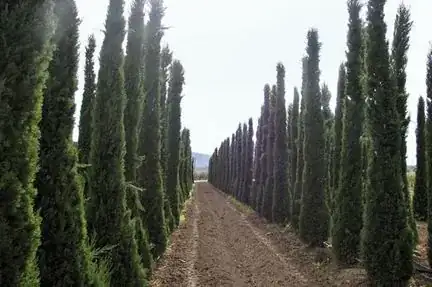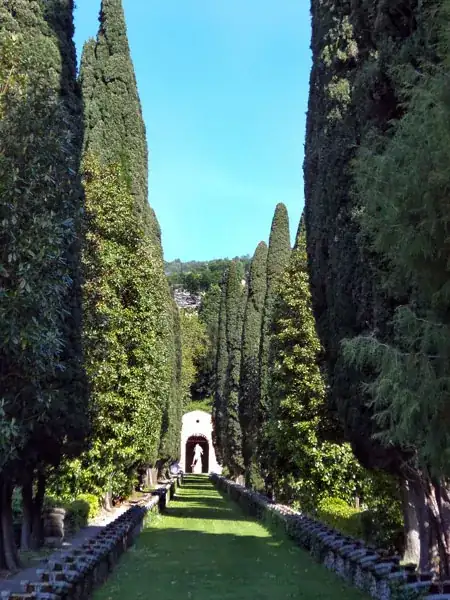Here in Montana, high winds are a common cause for both gardening problems and poor energy efficiency in homes (as well as maintenance issues). Can anyone recommend some low-maintenance plants that would shelter both other plants and the side of a leaky house from frequent high winds? I suspect evergreens would be best, but which ones? They need to withstand temperature extremes from below -30F to over 100F and winds that often gust over 30mph (50 possible) and be tall enough to serve as a wind break for at least a single-story building.
4 Answers
Short answer: if you're looking for the simplest thing that will give you the most value, buy some Western white pine and Grand fir seedlings and plant them about 6' apart in rows about 6' apart like this:
P P P P P
F F F F F
P P P P P
Thin them (i.e. cut some down) as they grow if needed (you will have losses). The pines will tend to grow faster than the firs.
Long answer (I've been doing research for a windbreak of my own):
I'd suggest a mix of species. You'll want something fast growing so that you can have protection early -- but fast growing trees tend to not be as strong, so plan on losing them when they are still young. Interplant with something slower growing and stronger. Deciduous trees provide less protection in winter but they will still slow down the wind so your house isn't getting the full force.
You can have multiple layers of windbreak, with some smaller trees/shrubs closer to the house -- deciduous trees on the south side of your house can keep it cooler in the summer when those 100°F temperatures hit.
Having a mix of species means that you are more likely to have more trees survive in the event that you have an outbreak of pests or disease that affect a particular species.
This article provides some good general information about building a windbreak:
On the windward side of a windbreak, wind speed reductions are measurable upwind for a distance of 2 to 5 times the height of the windbreak (2H to 5H). On the leeward side (the side away from the wind), wind speed reductions occur up to 30H downwind of the barrier. For example, in a windbreak where the tallest trees are 30 ft, lower wind speeds are measurable for 60 ft to 150 ft on the windward side, and up to 900 ft on the leeward side. Within this protected zone, the structural characteristics of a windbreak, especially density, determine the extent of wind speed reductions.
They also talk about density of planting:
A windbreak density of 40 to 60 percent provides the greatest downwind area of protection and provides excellent soil erosion control.
Keep in mind the size of the trees at maturity. I, for one, do not want an 80' tall tree closer than about 100' of my house in case it blows over or drops a large branch in a 50mph windstorm.
This paper from the 70s is specific to Montana and provides a list of trees and their windbreak performance on different soils around the state. You may be able to get some ideas there; I've borrowed a couple of species from their list in my list below.
Some ideas below -- I'm not familiar with these species since you're in Montana and I'm on the east coast, but these are what I've come up with based on a couple of searches. You may want to investigate further to make sure they're appropriate for your site.
- Abies spp. -- Firs, e.g. Abies grandis (grand fir) is a large tree (150') that is shown as growing in Montana, with a moderate growth rate (25' in 20 years). Other firs may be suitable. You can buy firs in quantity for very low cost. (E.g. the NH State Forest Nursery sells Balsam Fir for $45 per 100 seedlings; expect losses of up to 50% if you plant at this size and have a bad first couple of years.)
- Pigea spp. Spruce is a similar story to fir.
- Very fast growing trees like hybrid poplars (e.g. P. deltoides x nigra (OP-367)) can be started from cuttings in bulk for relatively low cost. (E.g. This guy sells 100 cuttings for $49 plus shipping -- I have a batch of 17 from him that have all successfully started on my windowsill.) As mentioned above, these will be brittle and prone to breakage, but they shoot up fast and can be coppiced, so they can provide some amount of initial protection for the other trees in your wind break. This may not qualify as low maintenance if you aren't willing to deal with trees that may need to be cut down in as few as 5-10 years, but with a little planning it doesn't seem that bad to me. They also provide a decent quantity of relatively low-quality but easy to process firewood, if that's something that's useful to you.
- Relatively fast growing conifers like Pinus contorta (lodgepole pine) or Pinus monticola (western white pine). These are both large evergreens with fast growth, but neither as fast nor as brittle as something like the poplar. Cost on these seedlings will be about the same as for fir (NH Nursery sells for same price as fir -- $45 per 100.)
- Slow-to-moderate growing deciduous trees like Green Ash or Cottonwood may be good choices.
- Shrubs like Caragana arborescens (Siberian Pea Shrub) only grow to 10-20' tall and grow to that size relatively quickly. This might be a good choice for a row of shrubs closer to the house or on the windward size of a garden.
- Prunus americana (American plum) might be another choice for an inner row.
- 41,452
- 7
- 111
- 235
-
I disagree about the spacing. 6 foot spacing is way too close, particularly in a dry climate. I would recommend 12 to 15 foot spacing. Close spacing does two things: It makes it difficult to mow between (Mower width + 3 feet is the minimum I recommend) It sets the trees up for failure from water conflict in about 20 years. – Sherwood Botsford Apr 23 '13 at 19:20
-
Is WWP prairie hardy? I thought it tended to be a zone 5 tree, and even in northern Idaho, it tends to favor sheltered spots with extra water. For similar reason I would question grand fir. – Sherwood Botsford Apr 23 '13 at 19:24
-
Paper linked to in "This Paper from the 70's" does not refer to Montana, but goes to the same paper as the first link. – Sherwood Botsford Apr 23 '13 at 19:26
-
@SherwoodBotsford: thanks for the correction, I fixed the link. – bstpierre Apr 23 '13 at 20:11
-
Re: 6' spacing. In my experience *with Christmas tree seedlings on the east coast*, 6' is easy to mow around with a homeowner-sized riding mower (deck of 48" or so) when they're small. I agree with your mention of water conflict *in 20 years*, which is why I said that they should be thinned if needed in the future. If you're planting 6-12" seedlings, you're likely to get a 50% failure rate -- maybe more in a dry climate. I chose WWP and Grand Fir based on a couple of searches; I'd defer to your choices since you know the climate from first-hand experience. – bstpierre Apr 23 '13 at 20:19
Montana is high plains. Bitter cold winters, hot summers. Dry all year. I don't think cedar will work here. Some of the upright junipers might be ok.
My experience is based on Canadian Prairie. Even colder winters, cool summers, similar precipitation.
Good information about shelterbelts:
- Trees and Shrubs for Prairie Shelterbelts (Agriculture and Agri-Food Canada)
- Shelterbelt Varieties for Alberta (Alberta Agriculture and Rural Development)
In the long haul you want several rows of trees/shrubs at varying height. At minimum you want two rows, planted checkboard style, with one very fast growing tree and one conifer. The fast growing tree gives you some results quickly. The conifer provides better winter protection in the long run. The checkboard pattern maximizes the distance between two trees of the same species (different root patterns = less water conflict.
If you have the water (20 inches of precip/year) I would use hybrid poplar for the quick tree -- probably Hill or Okanese. Golden willow may work too. Here it will grow on glacial till. Green Ash, mantitoba maple (box elder) are also possible. Here it will grow on glacial till.
In addition to your native pines, consider Mountain Pine, Austrian pine (Zone 3 variant). Colorado spruce should do well there. Concolor fir might be ok. It can handle the temps, but it may be too dry.
Trees should be 10-15 feet apart in row, and rows should be 12 feet apart. Shrubs can be 5 feet apart.
You MUST keep grass and weeds to a minimum until the trees are 8 feet tall. Mow as close as you can, or till carefully to not hit roots.
Water monthly during the first 3 years. Water deeply. Take a pail, put a 3/8" hole in the side at the bottom. Put a 2" cube of sponge in the hole. Fill with water. This will take several hours to drip out. Adding a rock will keep the pail from blowing away when empty.
At the shrub end: Wolf Willow, mugo pine, caragana, sea buckthorn, rocky moountain juniper, possibly chokecherry, lilac.
Swaling the rows can help. Before you plant, grade the land so that each row is at the bottom of a 6" deep by 12 foot wide v trench. This will cause runoff to concentrate on the trees. If your row is on a slope, you will need to build dams. The easiest way to do this is take and 8' blade, and make a 12' v blade that you can bolt to it. 1/4" plate should do it. To make dams, just lift the blade a few inches.
- 41,452
- 7
- 111
- 235
- 2,399
- 15
- 23
Thuja cupressum is the best. Is a genus belonging to the family Cupressaceae, native to Alaska, Lakes region in North America, China and Japan. They are used in both, Italy and French, as wall against strong and cold winds. They are tall and robust, capable of curbing high winds.

(source: supereva.it)
Throughout the centre-south of France are used to mark the borders of the crops and at the same time as effectively repair by the Mistral.
In Italy, due to the different location of urban centers, which here are almost always located on hilltops, are used to protect the access roads.
Villa d'Este, Cernobbio, Como

- 2,286
- 13
- 17
-
Most of the cedars that are hardy in Montana will get over 20 feet at maturity. They do provide shelter but do not stand up well to freezing rain or ice storms. – kevinskio Apr 17 '13 at 10:35
Used to see a lot of Elaeagnus angustifolia, Russian Olive, windbreaks in South Dakota. It will handle mid-Nevada, Ryepatch reservoir, Zone tolerance, up to 8, looks good for Montana. It's invasive in some areas, including Minnesota, so do some checking. Here's a start in the Yellowstone area, but Montana's a big state with quite a few ecosystems.
- 2,379
- 15
- 13